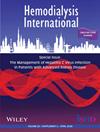The effect of implementing a dialysis start unit on modality decision among patients with unplanned start kidney replacement therapy
Abstract
Introduction
Many individuals start dialysis in an acute setting with suboptimal pre-dialysis education. These individuals are often treated with central venous catheter insertion and initiation of in-center hemodialysis and only a minority will transfer to a home-based therapy. The dialysis start unit is a program performing in-center hemodialysis in a separate space while providing support and education on chronic kidney disease and treatment options in the initial weeks of kidney replacement therapy. We aimed to assess the uptake of home dialysis therapies between 2013 and 2021 among patients who started acute inpatient hemodialysis at University Health Network, Toronto and underwent dialysis at the dialysis start unit.
Methods
This is a retrospective observational cohort study based on prospectively collected data. Patients' demographics were obtained from electronic charts. In the dialysis start unit, all patients received dialysis modality education by a nurse educator, dedicated home dialysis nurses, and the allied health care team.
Findings
During 2013–2021, 122 patients were dialyzed in the dialysis start unit and included in the study. Among those patients, 68 patients ultimately chose home dialysis (57 peritoneal dialysis and 11 home hemodialysis). Fifty-four patients continued in-center hemodialysis. Patients adopting home dialysis were less likely to have diabetes and hypertension as the etiology of kidney failure and more likely to have glomerulonephritis or vasculitis.
Discussion
Dialysis modality education is implementable in advanced chronic kidney disease. Individualized education and care after unplanned start dialysis can potentially enhance home dialysis choice and utilization.

 求助内容:
求助内容: 应助结果提醒方式:
应助结果提醒方式:


